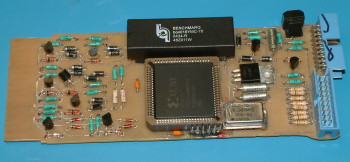I may use the technique again on simple boards but not boards of this complexity. Double sided boards are pretty cheap to have professionally made now if you aren't in a rush. The biggest advantage is professional boards have plated through holes. With the self etched board the top copper isn't connected to the bottom. With parts like the NVSRAM and the PLCC socket that cover the top pad soldering from the bottom won't connect traces that terminate at the top side pads. This made it much more difficult to route the board so many traces were done with wires. Professional board also allow small vias to change tracks between sides which also improves routing.
I realized I wouldn't compete the board in time so it got set aside until time to get ready for VCF East 2008. I pulled out the partially completed board, finished it and wrote the code for the CPLD. I got the board working in time so I was able to use it for running my demos. The original plan was to use the rotary switch on the board to select if it emulated 3 or 4 DS32 so it can be used with the DF32 and to select multiple disk images. I haven't implemented that yet since the moving of the card cage caused the DF32 head select cable to delaminate so I can't use its platter until I fix it. I also wanted to program it to be a timing track writer which is also still on the to-do list.
Here is the board schematic I used to make the PCB. The signals TBD and T1D which are outputs on the schematic should have been inputs to the DS32. They weren't needed for the emulator so I just left those signals unconnected. Their are some other issues which you may want to change if you make one. When the output signals go from the 0V to -3V the signal has a little glitch above ground. Putting a 1k resistor in the base will get rid of the glitch. For level shifting from the -3V logic to TTL I used resistor and the input protection diodes of the CPLD as a clamp. The voltage levels from the R series boards aren't that stable so the noise margin varies based on the levels of the particular signal. A transistor level shifter would be better though take more space which I didn't have. The last item is the two 20 pin connectors don't really fit in the board width. You probably want to use a different connector. Email me if you want the schematic as the gschem files I developed using.
Here is the CPLD code and constraints file. The code is messy since I ran out of CPLD resources so rearranged equations till it fit. When I come back to it I will see if I can get cleaner equations that fit. The next larger part would allow more flexibility. I may even add some comments.
I'm not including the PCB artwork since it had too many problems. If you really want it contact me.
The emulator board also requires two additional boards to pick up all the signals needed. I used a Douglas Electronics 21-DE-7 and a DEC W033C board which somebody had cut the cable off of. Since I ran out of space I put some of the resistors for the level shifting on the Douglas board. The emulator board was already longer than a proper DEC single height board.
The following picture links also have descriptions of what is shown in the pictures.

DS32 emulator boards ( 56K)
back of boards ( 58K)
Feel free to contact me, David Gesswein djg@pdp8online.com
with any questions, comments on the web site, or if you have related equipment,
documentation, software etc. you are willing to part with. I am
interested in anything PDP-8
related, computers, peripherals used with them, DEC or third party, or
documentation.
PDP-8 Home Page
PDP-8 Site Map
PDP-8 Site Search